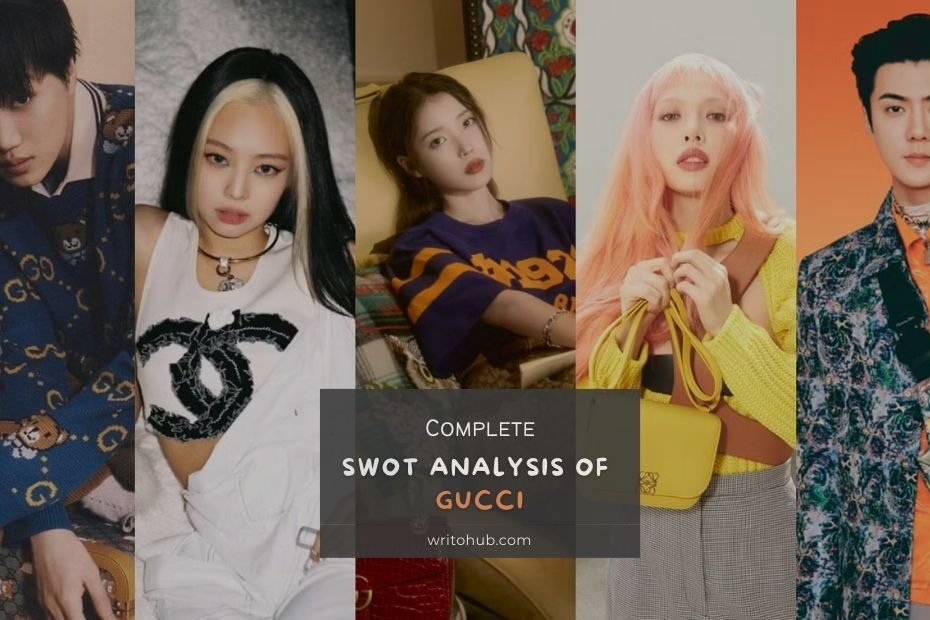Gucci, founded in 1921, is a prestigious Italian luxury fashion brand known for its iconic designs, high-quality craftsmanship, and association with luxury and sophistication.
Conducting a SWOT analysis of Gucci allows us to assess its internal strengths and weaknesses, as well as external opportunities and threats.
This analysis provides insights into Gucci’s current market position and helps identify strategic areas for growth and improvement.
Strengths in the SWOT Analysis of Gucci
- Strong Brand Identity: Gucci enjoys a powerful and recognizable brand identity. The brand’s iconic logo, distinctive design elements, and celebrity endorsements contribute to its status as a symbol of luxury and fashion excellence.
- Product Diversification: Gucci offers a diverse range of products, including luxury handbags, apparel, accessories, footwear, and fragrances. The brand’s extensive product portfolio appeals to a wide range of affluent consumers.
- Innovative Designs: Gucci’s focus on innovation and creativity has led to groundbreaking designs that set trends in the fashion industry. The brand’s ability to reinvent classic styles while maintaining its heritage attracts fashion-forward customers.
- Strong Digital Presence: Gucci has made significant strides in the digital realm, leveraging social media and e-commerce to connect with a global audience. The brand’s digital marketing efforts have strengthened its online presence and customer engagement.
- Global Presence: Gucci has a strong global presence with boutiques located in major fashion capitals and luxury shopping destinations worldwide. This widespread retail network enables the brand to cater to affluent consumers across different regions.
Weaknesses in the SWOT Analysis of Gucci
- High Price Points: Gucci’s luxury positioning and high-quality craftsmanship result in premium pricing. While this exclusivity enhances the brand’s desirability, it may limit accessibility to a broader consumer base.
- Counterfeit Products: Gucci’s popularity makes it vulnerable to counterfeit products in the market. Counterfeits not only harm brand reputation but also compete with genuine products, impacting sales and customer trust.
Opportunities in the SWOT Analysis of Gucci
- Digital Transformation: Embracing digital technologies and expanding e-commerce capabilities can further enhance Gucci’s online presence and customer experience. Augmented reality (AR) shopping, personalized recommendations, and interactive content can drive online sales and engagement.
- Expansion in Emerging Markets: The rising affluence and interest in luxury brands in emerging markets present growth opportunities for Gucci. Expanding retail operations and marketing efforts in countries like China and India can tap into this growing consumer base.
- Sustainable Fashion: Gucci can further invest in sustainable and eco-friendly practices, appealing to environmentally-conscious consumers. Incorporating sustainable materials and initiatives into its product offerings can enhance the brand’s reputation and attract socially responsible customers.
- Collaboration and Limited Editions: Partnering with influential designers, artists, and celebrities for limited-edition collections can create excitement, generate buzz, and attract new customers.
Threats in the SWOT Analysis of Gucci
- Intense Competition: Gucci faces fierce competition from other luxury fashion brands and emerging designers. Competitors’ innovative designs, marketing strategies, and brand positioning pose a threat to Gucci’s market share and exclusivity.
- Economic Volatility: Luxury brands are vulnerable to economic downturns and fluctuations in consumer spending. Economic uncertainties can impact consumer purchasing power, leading to reduced demand for luxury goods.
- Changing Consumer Behavior: Consumer preferences and luxury consumption habits can change rapidly. Staying attuned to evolving consumer needs and preferences is crucial to maintain relevance and meet customer expectations.
Conclusion
The SWOT analysis of Gucci highlights its strengths, weaknesses, opportunities, and threats in the dynamic luxury fashion industry.
Gucci’s strong brand identity, product diversification, innovative designs, digital presence, and global reach position it as a prestigious luxury fashion brand.
Addressing weaknesses related to high price points and counterfeit products is crucial for sustained growth. Seizing opportunities in digital transformation, expansion in emerging markets, sustainable fashion, and collaborations can drive Gucci’s success and innovation.
Mitigating threats from intense competition, economic volatility, and changing consumer behavior requires strategic planning, adaptability, and continuous investment in research and development.
By leveraging its strengths, addressing weaknesses, capitalizing on opportunities, and navigating threats, Gucci can continue to set trends, offer iconic luxury products, and maintain its position as a highly desirable and sought-after luxury fashion brand worldwide.
